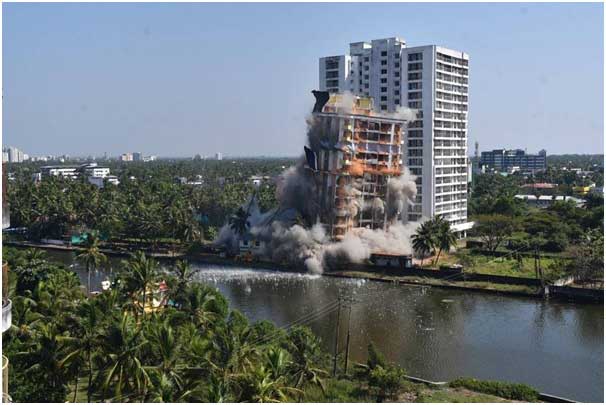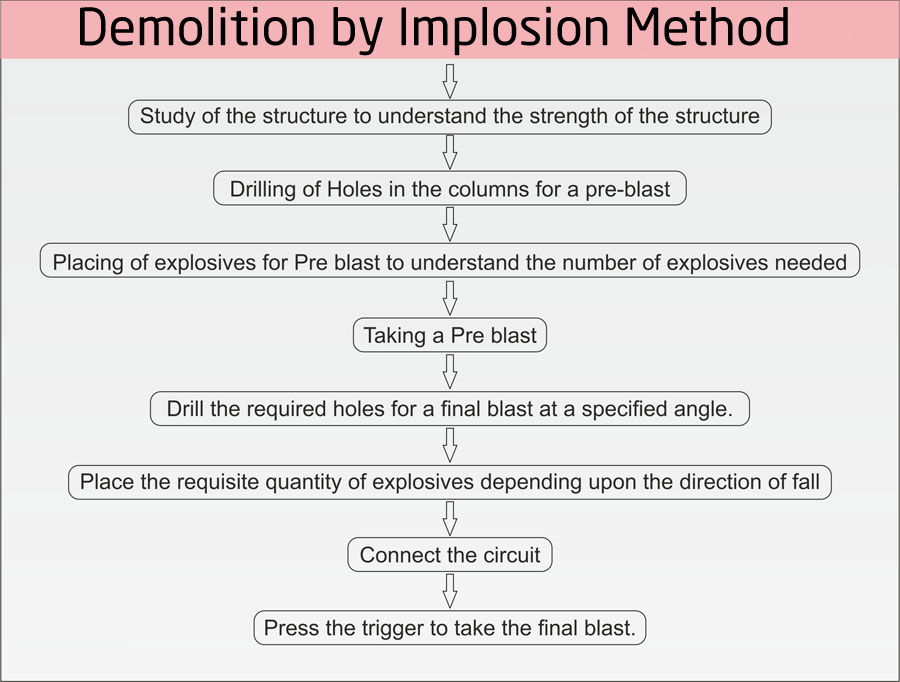Controlled demolition can be used on virtually any type of structure but is commonly utilised on buildings of significant height, bridges, chimney stacks and cooling towers. Tall buildings, such as tower blocks, are typically seen as the main buildings demolished by controlled demolition. It is essentially more cost and time efficient in bringing down a building of significant size and height to use explosives. But the use of this method depends on the surrounding area and whether there are other buildings in close proximity, and tenants and/or residents occupying those buildings. There are several methods adopted for controlled demolition, one such method is implosion.
Implosion is a method in which objects are destroyed by collapsing on themselves. True implosion usually involves a difference between internal (lower) and external (higher) pressure, or inward and outward forces, that is so large that the structure collapses inward into itself, or into space, it occupied if it is not a completely solid object.
In the controlled demolition industry, implosion is the strategic placing of explosive material and timing of its detonation so that a structure collapses on itself in a matter of seconds, minimizing the physical damage to its immediate surroundings.
The Technique of implosion
Before the execution of demolition work, the careful study of site condition, the type of structure, structural member, implosion range, rural or urban area and frequency is important.
An implosion is simply the opposite of an explosion. In an explosion, matter and energy fly outward, but in an implosion, matter, and energy collapse inward. All implosions will need some sort of pressure from the outside pushing in to cause the object to collapse. So in short, implosions are caused by having greater pressure on the outside of an object than on the inside. The technique is discussed below.
- The first step is to examine architectural blueprints of the building, if they can be located, to determine how the building is put together. Next, the blaster crew tours the building (several times), jotting down notes about the support structure on each floor. Once they have gathered all the raw data they need, the blasters hammer out a plan of attack.
- Building implosion techniques do not rely on the difference between internal and external pressure to collapse a structure. Instead, the goal is to induce a progressive collapse by weakening or removing critical support, therefore the building can no longer withstand gravity loads and will fail under its own weight.
- Numerous small explosives, strategically placed within the structure, are used to catalyze the collapse. Nitroglycerin, dynamite, or other explosives are used to shatter reinforced concrete supports. Linear shaped charges are used to sever steel supports. These explosives are progressively detonated on support throughout the structure. Then, explosives on the lower floors initiate the controlled collapse.
- A simple structure like a chimney can be prepared for demolition in less than a day. Larger or more complex structures can take up to six months of preparation to remove internal walls and wrap columns with fabric and fencing before firing the explosives.
- Demolition blasters load explosives on several different levels of the building so that the building structure falls down on itself at multiple points. When everything is planned and executed correctly, the total damage of the explosives and falling building material is sufficient to collapse the structure entirely, so cleanup crews are left with only a pile of rubble.
- Blasters approach each project a little differently, but the basic idea is to think of the building as a collection of separate towers. The blasters set the explosives so that each “tower” falls toward the center of the building, in roughly the same way that they would set the explosives to topple a single structure to the side. When the explosives are detonated in the right order, the toppling towers crash against each other, and all of the rubble collects at the center of the building. Another option is to detonate the columns at the center of the building before the other columns so that the building’s sides fall inward.
- Sometimes, though, a building is surrounded by structures that must be preserved. In this case, the blasters proceed with a true implosion, demolishing the building so that it collapses straight down into its own footprint (the total area at the base of the building). This feat requires such skill that only a handful of demolition companies in the world will attempt it.
The recent case of implosion demolition India – Maradu implosion, Kochi

Two of the four apartment complexes in Maradu in Kerala’s Kochi were demolished in a controlled implosion on Saturday after the Supreme Court’s order in May last year for violating the Coastal Zone Regulation (CZR) norms.
Described as the first such implosion in the country of this dimension two luxury waterfront high-rises in the Maradu district of Kochi city were literally razed to dust on Saturday.
Delayed by about 17 minutes according to what was on offer on television within a few seconds after the trigger for the blast was pressed, at 11.17 a.m. the 19 storied H2O Holy Faith was raised to the ground as a huge cloud of dust mushroomed up covering a huge area. The first block of AAlfa Serene flats were also demolished and a minute later the second block followed it to the ground.
At 10.32 a.m. the first siren was sounded to announce that the evacuation of all from the neighbourhood was complete and soon came the stopping of all vehicular traffic in the locality. Ahead of the second siren that came about at 11.10 a.m., a Naval helicopter took five aerial survey of the area to make sure that everything is in order, including the stopping of all vehicular movement. The third siren came at 11.16 a.m., which is the call given to the blasters to press the trigger and a minute after that the 19 floor H2O Holy Faith flat came down, leaving the entire area in a cover of white smoke. Four fire tenders immediately reached the site and sprayed water to reduce the dust particles.
The two buildings in the Maradu apartment complexes, spread in at least 800,000 square feet area, were razed within seconds, in one of the largest demolition drives in the country involving residential buildings.
The Jain Coral Cove, which had the maximum number of housing units among the four, was razed without incident as per schedule. The 55-meter high “Golden Kayaloram”, the smallest among the four buildings constructed violating the Coastal Regulation Zone norms, was demolished at around 2.30 pm on January 12th. The 55-meter high “Golden Kayaloram”, the smallest among the four buildings constructed violating the Coastal Regulation Zone norms, was demolished at around 2.30 pm. Two complexes — H2O Holy Faith and the twin towers of Alfa Serene — abutting the backwaters were destroyed in the similar implosion method in which explosives filled in the structures blasted in a controlled manner.

Conclusion
Contrary to popular belief the implosion process is far bigger than just blowing up stuff. A successful implosion occurs if the conditions mentioned above are appropriately addressed and executed. If you have a massive building surrounded by other buildings you need to find means to properly implode the building. Nevertheless, a great implosion expert needs to understand all these methods and when to use them.


